An Analysis of the Struggles and Hardships of Low-Income Families
VerifiedAdded on 2021/04/24
|7
|2246
|98
Essay
AI Summary
This essay delves into the multifaceted challenges faced by low-income families, highlighting the significant burdens they endure. It explores the impact of financial constraints on various aspects of life, including housing, nutrition, healthcare, and education. The essay discusses how these families often struggle to meet basic needs while navigating societal expectations, leading to increased stress and family instability. It examines the consequences of low income on children, such as limited access to quality education and healthcare, and the potential for mental health issues. Furthermore, the essay analyzes government policies and social programs designed to alleviate poverty and improve the living standards of low-income families, including empowerment initiatives, employment programs, healthcare provisions, and educational support. It also references the roles of international organizations like the FAO and WHO in addressing poverty and promoting human rights. The conclusion emphasizes the critical need for awareness and accessible resources to help low-income families overcome their hardships and achieve a better quality of life.
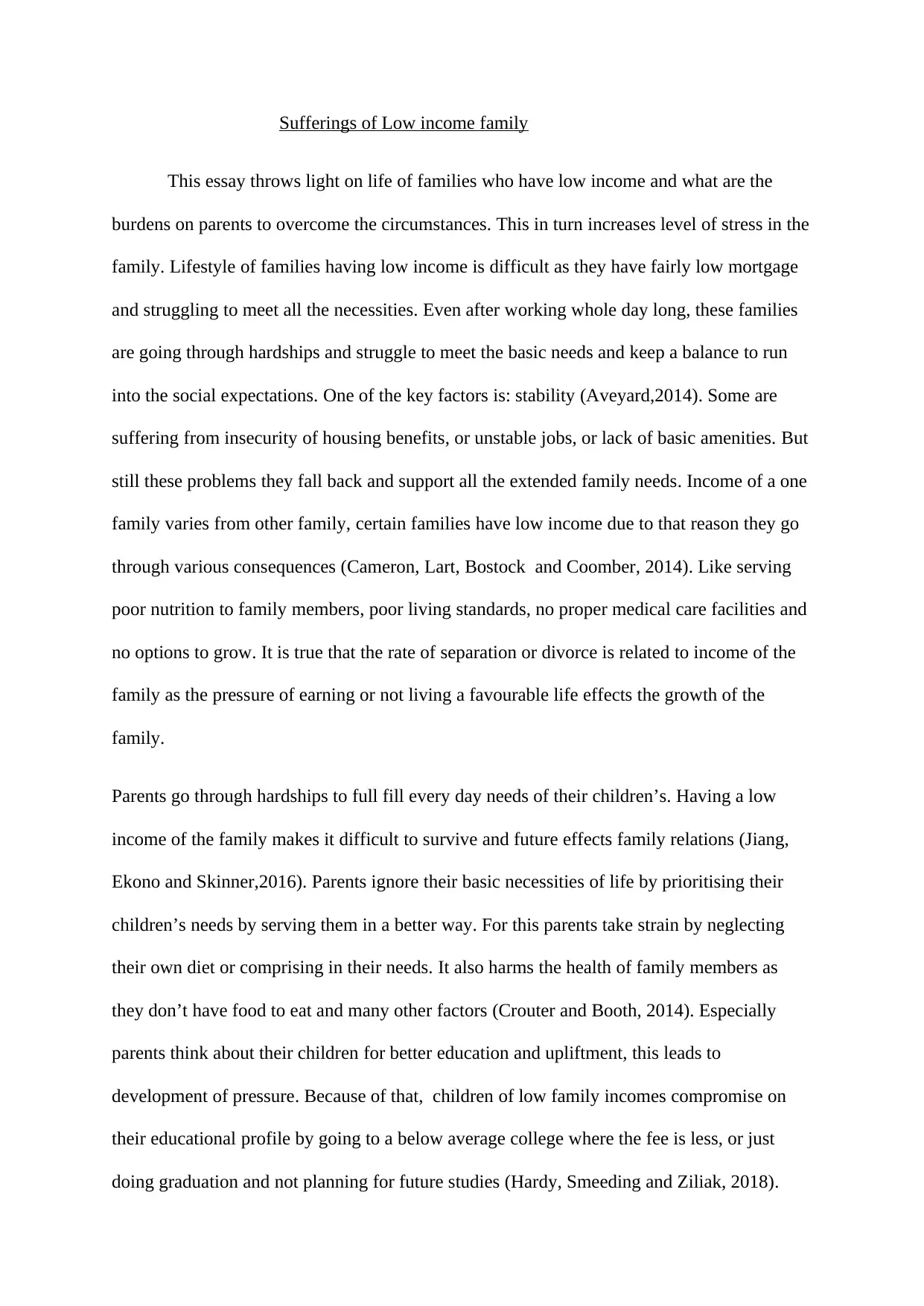
Sufferings of Low income family
This essay throws light on life of families who have low income and what are the
burdens on parents to overcome the circumstances. This in turn increases level of stress in the
family. Lifestyle of families having low income is difficult as they have fairly low mortgage
and struggling to meet all the necessities. Even after working whole day long, these families
are going through hardships and struggle to meet the basic needs and keep a balance to run
into the social expectations. One of the key factors is: stability (Aveyard,2014). Some are
suffering from insecurity of housing benefits, or unstable jobs, or lack of basic amenities. But
still these problems they fall back and support all the extended family needs. Income of a one
family varies from other family, certain families have low income due to that reason they go
through various consequences (Cameron, Lart, Bostock and Coomber, 2014). Like serving
poor nutrition to family members, poor living standards, no proper medical care facilities and
no options to grow. It is true that the rate of separation or divorce is related to income of the
family as the pressure of earning or not living a favourable life effects the growth of the
family.
Parents go through hardships to full fill every day needs of their children’s. Having a low
income of the family makes it difficult to survive and future effects family relations (Jiang,
Ekono and Skinner,2016). Parents ignore their basic necessities of life by prioritising their
children’s needs by serving them in a better way. For this parents take strain by neglecting
their own diet or comprising in their needs. It also harms the health of family members as
they don’t have food to eat and many other factors (Crouter and Booth, 2014). Especially
parents think about their children for better education and upliftment, this leads to
development of pressure. Because of that, children of low family incomes compromise on
their educational profile by going to a below average college where the fee is less, or just
doing graduation and not planning for future studies (Hardy, Smeeding and Ziliak, 2018).
This essay throws light on life of families who have low income and what are the
burdens on parents to overcome the circumstances. This in turn increases level of stress in the
family. Lifestyle of families having low income is difficult as they have fairly low mortgage
and struggling to meet all the necessities. Even after working whole day long, these families
are going through hardships and struggle to meet the basic needs and keep a balance to run
into the social expectations. One of the key factors is: stability (Aveyard,2014). Some are
suffering from insecurity of housing benefits, or unstable jobs, or lack of basic amenities. But
still these problems they fall back and support all the extended family needs. Income of a one
family varies from other family, certain families have low income due to that reason they go
through various consequences (Cameron, Lart, Bostock and Coomber, 2014). Like serving
poor nutrition to family members, poor living standards, no proper medical care facilities and
no options to grow. It is true that the rate of separation or divorce is related to income of the
family as the pressure of earning or not living a favourable life effects the growth of the
family.
Parents go through hardships to full fill every day needs of their children’s. Having a low
income of the family makes it difficult to survive and future effects family relations (Jiang,
Ekono and Skinner,2016). Parents ignore their basic necessities of life by prioritising their
children’s needs by serving them in a better way. For this parents take strain by neglecting
their own diet or comprising in their needs. It also harms the health of family members as
they don’t have food to eat and many other factors (Crouter and Booth, 2014). Especially
parents think about their children for better education and upliftment, this leads to
development of pressure. Because of that, children of low family incomes compromise on
their educational profile by going to a below average college where the fee is less, or just
doing graduation and not planning for future studies (Hardy, Smeeding and Ziliak, 2018).
Paraphrase This Document
Need a fresh take? Get an instant paraphrase of this document with our AI Paraphraser
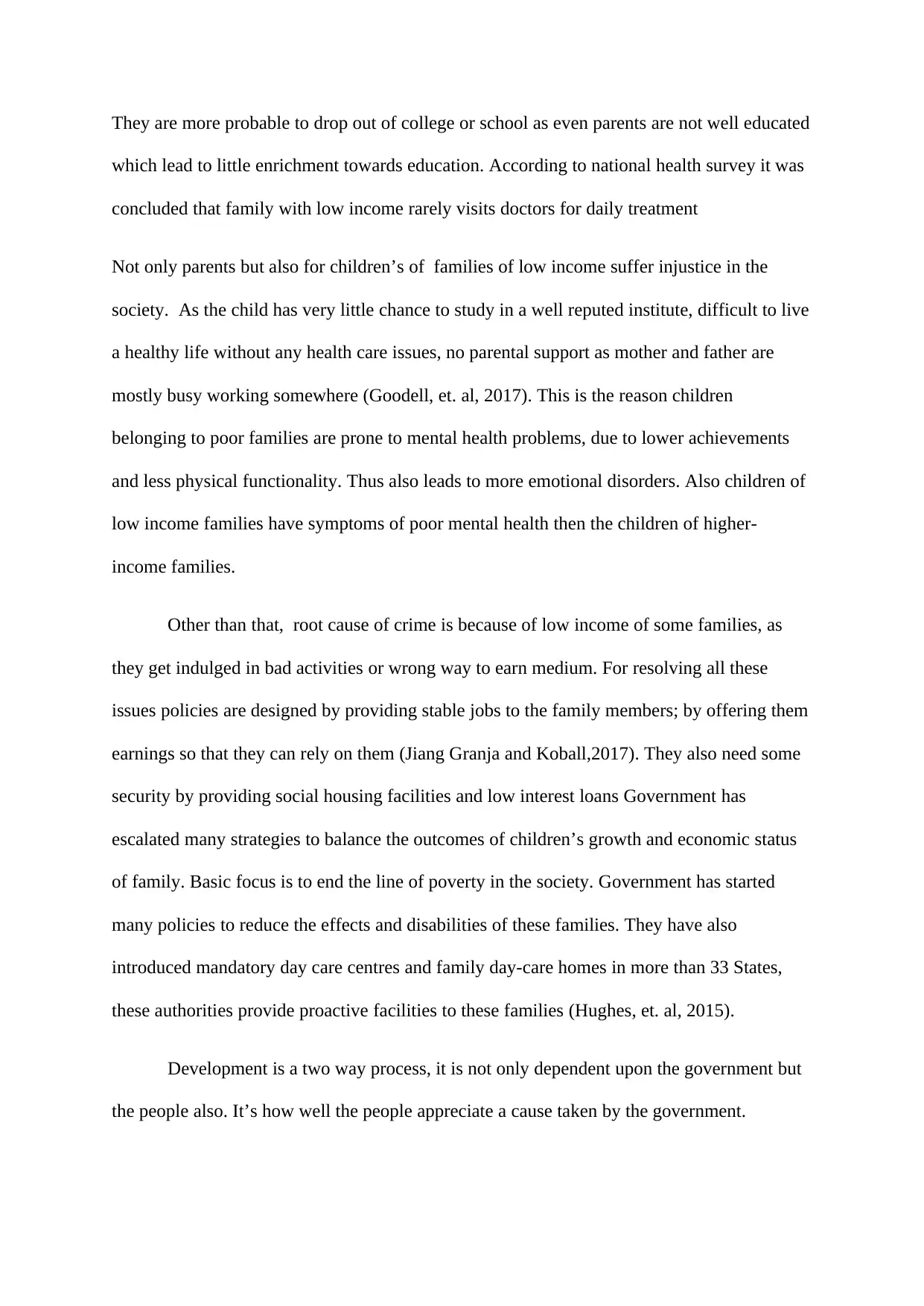
They are more probable to drop out of college or school as even parents are not well educated
which lead to little enrichment towards education. According to national health survey it was
concluded that family with low income rarely visits doctors for daily treatment
Not only parents but also for children’s of families of low income suffer injustice in the
society. As the child has very little chance to study in a well reputed institute, difficult to live
a healthy life without any health care issues, no parental support as mother and father are
mostly busy working somewhere (Goodell, et. al, 2017). This is the reason children
belonging to poor families are prone to mental health problems, due to lower achievements
and less physical functionality. Thus also leads to more emotional disorders. Also children of
low income families have symptoms of poor mental health then the children of higher-
income families.
Other than that, root cause of crime is because of low income of some families, as
they get indulged in bad activities or wrong way to earn medium. For resolving all these
issues policies are designed by providing stable jobs to the family members; by offering them
earnings so that they can rely on them (Jiang Granja and Koball,2017). They also need some
security by providing social housing facilities and low interest loans Government has
escalated many strategies to balance the outcomes of children’s growth and economic status
of family. Basic focus is to end the line of poverty in the society. Government has started
many policies to reduce the effects and disabilities of these families. They have also
introduced mandatory day care centres and family day-care homes in more than 33 States,
these authorities provide proactive facilities to these families (Hughes, et. al, 2015).
Development is a two way process, it is not only dependent upon the government but
the people also. It’s how well the people appreciate a cause taken by the government.
which lead to little enrichment towards education. According to national health survey it was
concluded that family with low income rarely visits doctors for daily treatment
Not only parents but also for children’s of families of low income suffer injustice in the
society. As the child has very little chance to study in a well reputed institute, difficult to live
a healthy life without any health care issues, no parental support as mother and father are
mostly busy working somewhere (Goodell, et. al, 2017). This is the reason children
belonging to poor families are prone to mental health problems, due to lower achievements
and less physical functionality. Thus also leads to more emotional disorders. Also children of
low income families have symptoms of poor mental health then the children of higher-
income families.
Other than that, root cause of crime is because of low income of some families, as
they get indulged in bad activities or wrong way to earn medium. For resolving all these
issues policies are designed by providing stable jobs to the family members; by offering them
earnings so that they can rely on them (Jiang Granja and Koball,2017). They also need some
security by providing social housing facilities and low interest loans Government has
escalated many strategies to balance the outcomes of children’s growth and economic status
of family. Basic focus is to end the line of poverty in the society. Government has started
many policies to reduce the effects and disabilities of these families. They have also
introduced mandatory day care centres and family day-care homes in more than 33 States,
these authorities provide proactive facilities to these families (Hughes, et. al, 2015).
Development is a two way process, it is not only dependent upon the government but
the people also. It’s how well the people appreciate a cause taken by the government.
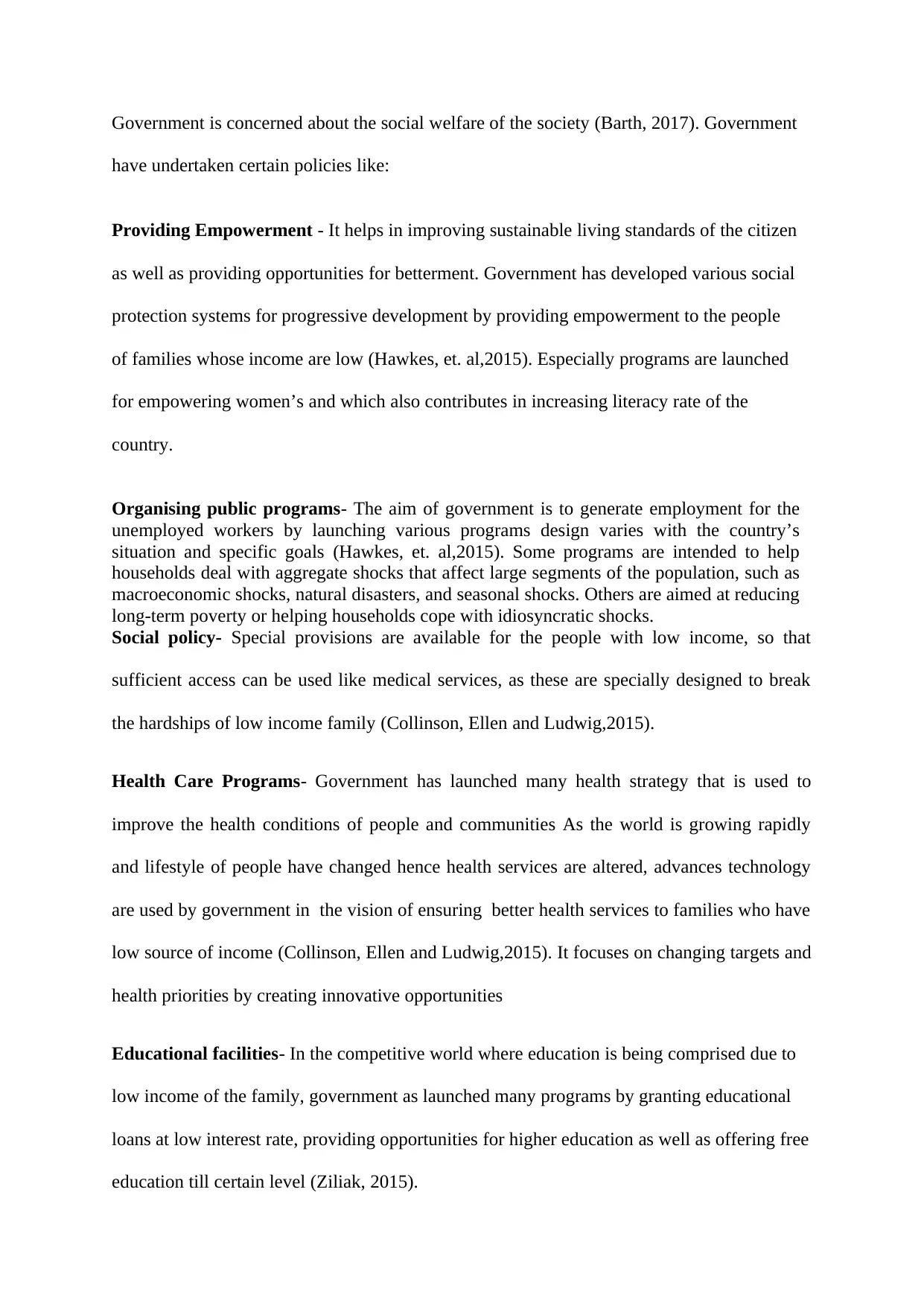
Government is concerned about the social welfare of the society (Barth, 2017). Government
have undertaken certain policies like:
Providing Empowerment - It helps in improving sustainable living standards of the citizen
as well as providing opportunities for betterment. Government has developed various social
protection systems for progressive development by providing empowerment to the people
of families whose income are low (Hawkes, et. al,2015). Especially programs are launched
for empowering women’s and which also contributes in increasing literacy rate of the
country.
Organising public programs- The aim of government is to generate employment for the
unemployed workers by launching various programs design varies with the country’s
situation and specific goals (Hawkes, et. al,2015). Some programs are intended to help
households deal with aggregate shocks that affect large segments of the population, such as
macroeconomic shocks, natural disasters, and seasonal shocks. Others are aimed at reducing
long-term poverty or helping households cope with idiosyncratic shocks.
Social policy- Special provisions are available for the people with low income, so that
sufficient access can be used like medical services, as these are specially designed to break
the hardships of low income family (Collinson, Ellen and Ludwig,2015).
Health Care Programs- Government has launched many health strategy that is used to
improve the health conditions of people and communities As the world is growing rapidly
and lifestyle of people have changed hence health services are altered, advances technology
are used by government in the vision of ensuring better health services to families who have
low source of income (Collinson, Ellen and Ludwig,2015). It focuses on changing targets and
health priorities by creating innovative opportunities
Educational facilities- In the competitive world where education is being comprised due to
low income of the family, government as launched many programs by granting educational
loans at low interest rate, providing opportunities for higher education as well as offering free
education till certain level (Ziliak, 2015).
have undertaken certain policies like:
Providing Empowerment - It helps in improving sustainable living standards of the citizen
as well as providing opportunities for betterment. Government has developed various social
protection systems for progressive development by providing empowerment to the people
of families whose income are low (Hawkes, et. al,2015). Especially programs are launched
for empowering women’s and which also contributes in increasing literacy rate of the
country.
Organising public programs- The aim of government is to generate employment for the
unemployed workers by launching various programs design varies with the country’s
situation and specific goals (Hawkes, et. al,2015). Some programs are intended to help
households deal with aggregate shocks that affect large segments of the population, such as
macroeconomic shocks, natural disasters, and seasonal shocks. Others are aimed at reducing
long-term poverty or helping households cope with idiosyncratic shocks.
Social policy- Special provisions are available for the people with low income, so that
sufficient access can be used like medical services, as these are specially designed to break
the hardships of low income family (Collinson, Ellen and Ludwig,2015).
Health Care Programs- Government has launched many health strategy that is used to
improve the health conditions of people and communities As the world is growing rapidly
and lifestyle of people have changed hence health services are altered, advances technology
are used by government in the vision of ensuring better health services to families who have
low source of income (Collinson, Ellen and Ludwig,2015). It focuses on changing targets and
health priorities by creating innovative opportunities
Educational facilities- In the competitive world where education is being comprised due to
low income of the family, government as launched many programs by granting educational
loans at low interest rate, providing opportunities for higher education as well as offering free
education till certain level (Ziliak, 2015).
⊘ This is a preview!⊘
Do you want full access?
Subscribe today to unlock all pages.

Trusted by 1+ million students worldwide
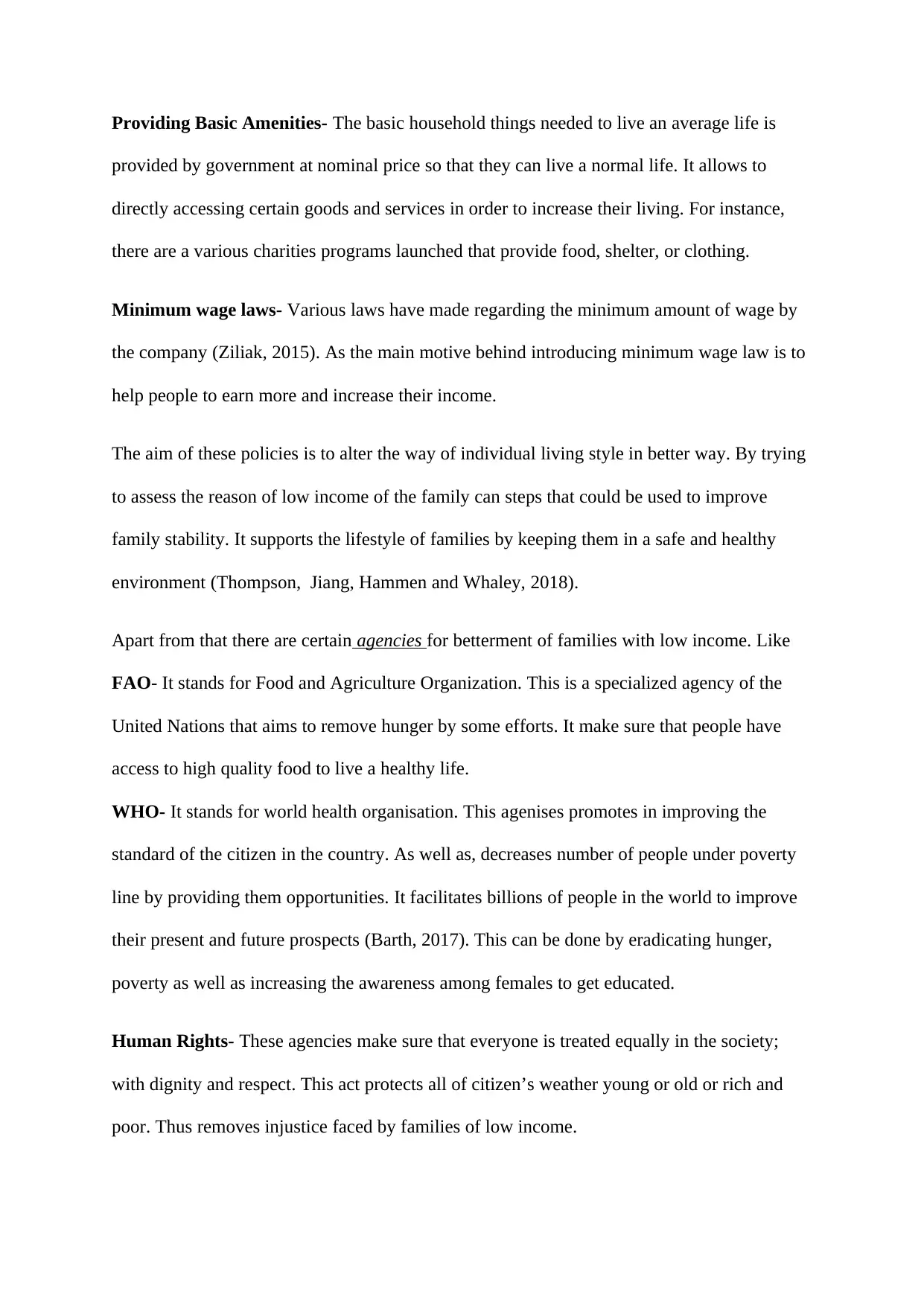
Providing Basic Amenities- The basic household things needed to live an average life is
provided by government at nominal price so that they can live a normal life. It allows to
directly accessing certain goods and services in order to increase their living. For instance,
there are a various charities programs launched that provide food, shelter, or clothing.
Minimum wage laws- Various laws have made regarding the minimum amount of wage by
the company (Ziliak, 2015). As the main motive behind introducing minimum wage law is to
help people to earn more and increase their income.
The aim of these policies is to alter the way of individual living style in better way. By trying
to assess the reason of low income of the family can steps that could be used to improve
family stability. It supports the lifestyle of families by keeping them in a safe and healthy
environment (Thompson, Jiang, Hammen and Whaley, 2018).
Apart from that there are certain agencies for betterment of families with low income. Like
FAO- It stands for Food and Agriculture Organization. This is a specialized agency of the
United Nations that aims to remove hunger by some efforts. It make sure that people have
access to high quality food to live a healthy life.
WHO- It stands for world health organisation. This agenises promotes in improving the
standard of the citizen in the country. As well as, decreases number of people under poverty
line by providing them opportunities. It facilitates billions of people in the world to improve
their present and future prospects (Barth, 2017). This can be done by eradicating hunger,
poverty as well as increasing the awareness among females to get educated.
Human Rights- These agencies make sure that everyone is treated equally in the society;
with dignity and respect. This act protects all of citizen’s weather young or old or rich and
poor. Thus removes injustice faced by families of low income.
provided by government at nominal price so that they can live a normal life. It allows to
directly accessing certain goods and services in order to increase their living. For instance,
there are a various charities programs launched that provide food, shelter, or clothing.
Minimum wage laws- Various laws have made regarding the minimum amount of wage by
the company (Ziliak, 2015). As the main motive behind introducing minimum wage law is to
help people to earn more and increase their income.
The aim of these policies is to alter the way of individual living style in better way. By trying
to assess the reason of low income of the family can steps that could be used to improve
family stability. It supports the lifestyle of families by keeping them in a safe and healthy
environment (Thompson, Jiang, Hammen and Whaley, 2018).
Apart from that there are certain agencies for betterment of families with low income. Like
FAO- It stands for Food and Agriculture Organization. This is a specialized agency of the
United Nations that aims to remove hunger by some efforts. It make sure that people have
access to high quality food to live a healthy life.
WHO- It stands for world health organisation. This agenises promotes in improving the
standard of the citizen in the country. As well as, decreases number of people under poverty
line by providing them opportunities. It facilitates billions of people in the world to improve
their present and future prospects (Barth, 2017). This can be done by eradicating hunger,
poverty as well as increasing the awareness among females to get educated.
Human Rights- These agencies make sure that everyone is treated equally in the society;
with dignity and respect. This act protects all of citizen’s weather young or old or rich and
poor. Thus removes injustice faced by families of low income.
Paraphrase This Document
Need a fresh take? Get an instant paraphrase of this document with our AI Paraphraser
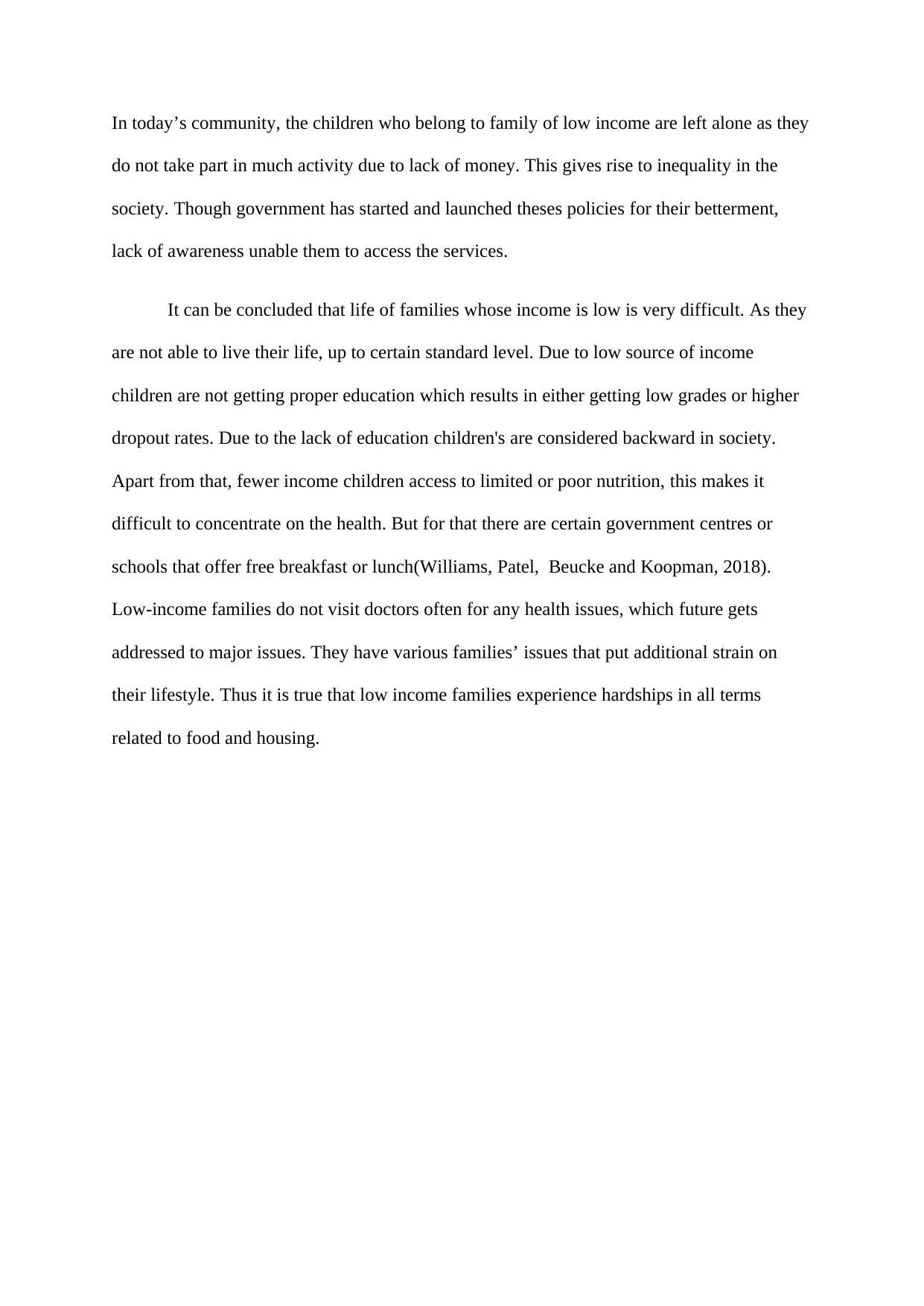
In today’s community, the children who belong to family of low income are left alone as they
do not take part in much activity due to lack of money. This gives rise to inequality in the
society. Though government has started and launched theses policies for their betterment,
lack of awareness unable them to access the services.
It can be concluded that life of families whose income is low is very difficult. As they
are not able to live their life, up to certain standard level. Due to low source of income
children are not getting proper education which results in either getting low grades or higher
dropout rates. Due to the lack of education children's are considered backward in society.
Apart from that, fewer income children access to limited or poor nutrition, this makes it
difficult to concentrate on the health. But for that there are certain government centres or
schools that offer free breakfast or lunch(Williams, Patel, Beucke and Koopman, 2018).
Low-income families do not visit doctors often for any health issues, which future gets
addressed to major issues. They have various families’ issues that put additional strain on
their lifestyle. Thus it is true that low income families experience hardships in all terms
related to food and housing.
do not take part in much activity due to lack of money. This gives rise to inequality in the
society. Though government has started and launched theses policies for their betterment,
lack of awareness unable them to access the services.
It can be concluded that life of families whose income is low is very difficult. As they
are not able to live their life, up to certain standard level. Due to low source of income
children are not getting proper education which results in either getting low grades or higher
dropout rates. Due to the lack of education children's are considered backward in society.
Apart from that, fewer income children access to limited or poor nutrition, this makes it
difficult to concentrate on the health. But for that there are certain government centres or
schools that offer free breakfast or lunch(Williams, Patel, Beucke and Koopman, 2018).
Low-income families do not visit doctors often for any health issues, which future gets
addressed to major issues. They have various families’ issues that put additional strain on
their lifestyle. Thus it is true that low income families experience hardships in all terms
related to food and housing.
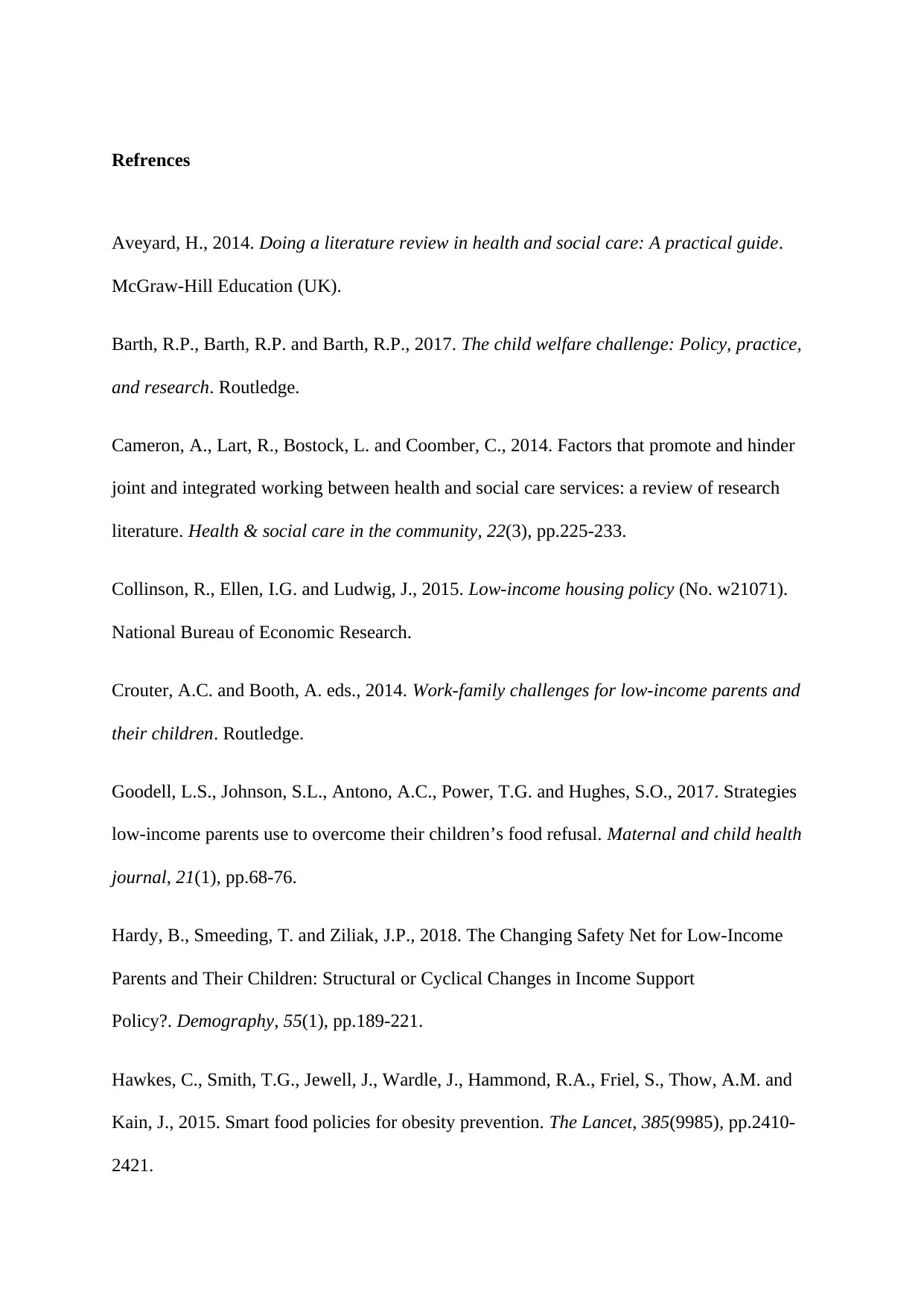
Refrences
Aveyard, H., 2014. Doing a literature review in health and social care: A practical guide.
McGraw-Hill Education (UK).
Barth, R.P., Barth, R.P. and Barth, R.P., 2017. The child welfare challenge: Policy, practice,
and research. Routledge.
Cameron, A., Lart, R., Bostock, L. and Coomber, C., 2014. Factors that promote and hinder
joint and integrated working between health and social care services: a review of research
literature. Health & social care in the community, 22(3), pp.225-233.
Collinson, R., Ellen, I.G. and Ludwig, J., 2015. Low-income housing policy (No. w21071).
National Bureau of Economic Research.
Crouter, A.C. and Booth, A. eds., 2014. Work-family challenges for low-income parents and
their children. Routledge.
Goodell, L.S., Johnson, S.L., Antono, A.C., Power, T.G. and Hughes, S.O., 2017. Strategies
low-income parents use to overcome their children’s food refusal. Maternal and child health
journal, 21(1), pp.68-76.
Hardy, B., Smeeding, T. and Ziliak, J.P., 2018. The Changing Safety Net for Low-Income
Parents and Their Children: Structural or Cyclical Changes in Income Support
Policy?. Demography, 55(1), pp.189-221.
Hawkes, C., Smith, T.G., Jewell, J., Wardle, J., Hammond, R.A., Friel, S., Thow, A.M. and
Kain, J., 2015. Smart food policies for obesity prevention. The Lancet, 385(9985), pp.2410-
2421.
Aveyard, H., 2014. Doing a literature review in health and social care: A practical guide.
McGraw-Hill Education (UK).
Barth, R.P., Barth, R.P. and Barth, R.P., 2017. The child welfare challenge: Policy, practice,
and research. Routledge.
Cameron, A., Lart, R., Bostock, L. and Coomber, C., 2014. Factors that promote and hinder
joint and integrated working between health and social care services: a review of research
literature. Health & social care in the community, 22(3), pp.225-233.
Collinson, R., Ellen, I.G. and Ludwig, J., 2015. Low-income housing policy (No. w21071).
National Bureau of Economic Research.
Crouter, A.C. and Booth, A. eds., 2014. Work-family challenges for low-income parents and
their children. Routledge.
Goodell, L.S., Johnson, S.L., Antono, A.C., Power, T.G. and Hughes, S.O., 2017. Strategies
low-income parents use to overcome their children’s food refusal. Maternal and child health
journal, 21(1), pp.68-76.
Hardy, B., Smeeding, T. and Ziliak, J.P., 2018. The Changing Safety Net for Low-Income
Parents and Their Children: Structural or Cyclical Changes in Income Support
Policy?. Demography, 55(1), pp.189-221.
Hawkes, C., Smith, T.G., Jewell, J., Wardle, J., Hammond, R.A., Friel, S., Thow, A.M. and
Kain, J., 2015. Smart food policies for obesity prevention. The Lancet, 385(9985), pp.2410-
2421.
⊘ This is a preview!⊘
Do you want full access?
Subscribe today to unlock all pages.

Trusted by 1+ million students worldwide
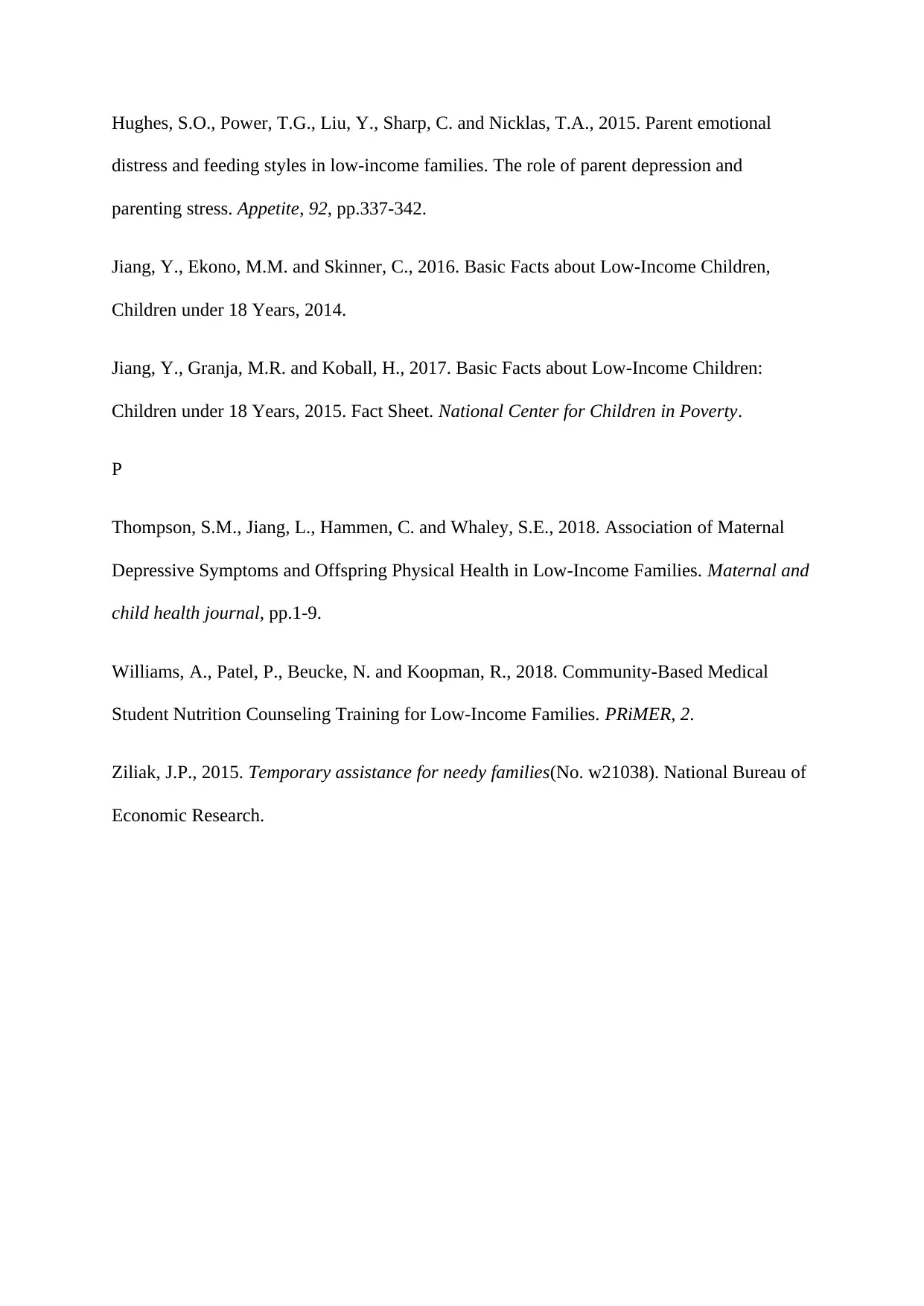
Hughes, S.O., Power, T.G., Liu, Y., Sharp, C. and Nicklas, T.A., 2015. Parent emotional
distress and feeding styles in low-income families. The role of parent depression and
parenting stress. Appetite, 92, pp.337-342.
Jiang, Y., Ekono, M.M. and Skinner, C., 2016. Basic Facts about Low-Income Children,
Children under 18 Years, 2014.
Jiang, Y., Granja, M.R. and Koball, H., 2017. Basic Facts about Low-Income Children:
Children under 18 Years, 2015. Fact Sheet. National Center for Children in Poverty.
P
Thompson, S.M., Jiang, L., Hammen, C. and Whaley, S.E., 2018. Association of Maternal
Depressive Symptoms and Offspring Physical Health in Low-Income Families. Maternal and
child health journal, pp.1-9.
Williams, A., Patel, P., Beucke, N. and Koopman, R., 2018. Community-Based Medical
Student Nutrition Counseling Training for Low-Income Families. PRiMER, 2.
Ziliak, J.P., 2015. Temporary assistance for needy families(No. w21038). National Bureau of
Economic Research.
distress and feeding styles in low-income families. The role of parent depression and
parenting stress. Appetite, 92, pp.337-342.
Jiang, Y., Ekono, M.M. and Skinner, C., 2016. Basic Facts about Low-Income Children,
Children under 18 Years, 2014.
Jiang, Y., Granja, M.R. and Koball, H., 2017. Basic Facts about Low-Income Children:
Children under 18 Years, 2015. Fact Sheet. National Center for Children in Poverty.
P
Thompson, S.M., Jiang, L., Hammen, C. and Whaley, S.E., 2018. Association of Maternal
Depressive Symptoms and Offspring Physical Health in Low-Income Families. Maternal and
child health journal, pp.1-9.
Williams, A., Patel, P., Beucke, N. and Koopman, R., 2018. Community-Based Medical
Student Nutrition Counseling Training for Low-Income Families. PRiMER, 2.
Ziliak, J.P., 2015. Temporary assistance for needy families(No. w21038). National Bureau of
Economic Research.
1 out of 7
Related Documents
Your All-in-One AI-Powered Toolkit for Academic Success.
+13062052269
info@desklib.com
Available 24*7 on WhatsApp / Email
![[object Object]](/_next/static/media/star-bottom.7253800d.svg)
Unlock your academic potential
Copyright © 2020–2025 A2Z Services. All Rights Reserved. Developed and managed by ZUCOL.





